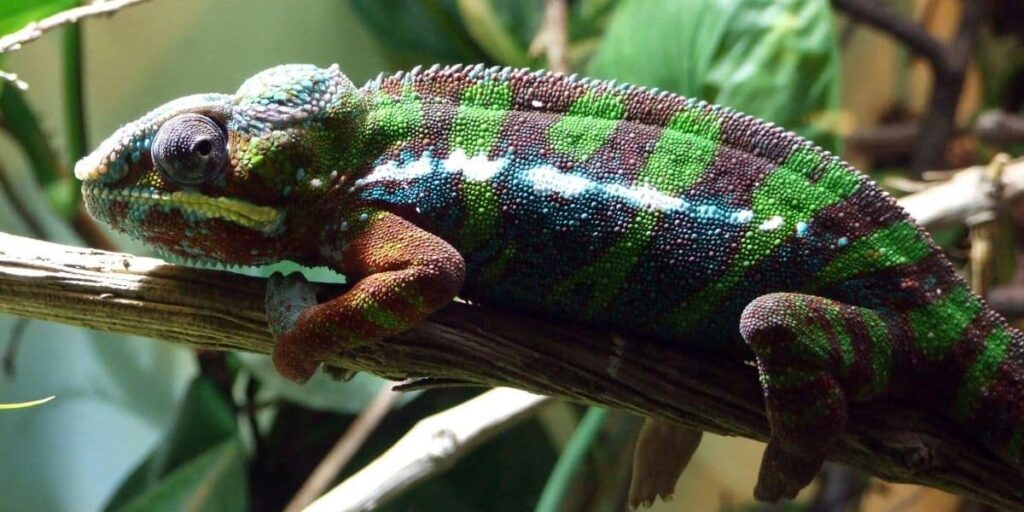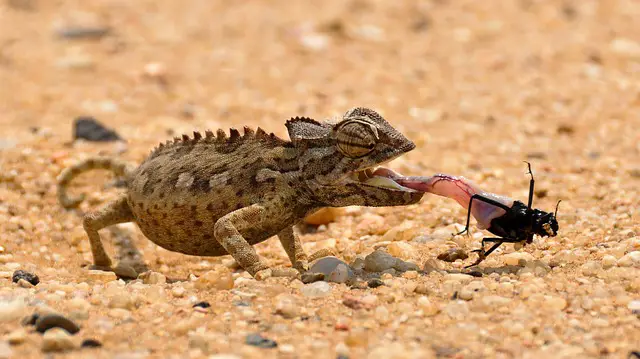One of the biggest draws of the chameleon to pet owners around the world is that these amazing animals are able to change color to blend into their surroundings.
Of course, this is a survival method since, in the wild, the chameleon needs to camouflage itself to avoid becoming a meal and to hide from prey.
Moreover, chameleons use color changes to let others know how they are feeling; something of a visual communication system.
But sometimes they may take on an unusual and potentially worrying color that can be alarming to owners.
The color of a chameleon differs depending on the species. For example, it is far more common for a veiled chameleon to remain brown for most of the day. This is usually because of basking and is a color that you will see regularly as a chameleon owner. After all, these animals will only change color when they need to, not as a display for their owners.
If you are concerned about your chameleon, it is important to always seek help from a vet. But to give you an idea of what the issue could be, we have outlined some of the most common reasons that a chameleon might turn brown.
What Colour Should My Chameleon Be?
Chameleons don’t come in a single uniform color especially when you consider the different chameleon varieties.
However, since the veiled chameleon is the type that might most often turn brown, let’s place our focus on this species.
Keep in mind that this type of chameleon is one of the most common that is kept as a pet. Although there are others such as the panther chameleon that can turn all kinds of colors including bright red.

These chameleons are generally light green in color and can come with a variety of markings and spots that are unique to each individual animal.
Along the side of the chameleon, there will normally be a lighter patch which is generally more prominent in younger specimens.
As they get older, the chameleon will develop into a slightly darker green color.
When chameleons turn brown, you will usually notice that they retain their markings and the bulk of their skin will go dark. The markings will most likely change color from a very light green to a beige shade.
Although again, this will differ between individuals.
Cold Chameleon
Chameleons are cold-blooded animals and as such, they need to bask to raise their body temperature. When keeping these creatures, you will need to provide them with temperatures anywhere between 21ºc and 27ºc.
However, from time to time, you may notice that your chameleon turns brown because he is cold.
This is pretty normal and provided that he has somewhere to bask and warm up, you shouldn’t be concerned.
The reason that your chameleon may have gone from green to brown is simply that brown is a darker color.
Imagine being outside on a hot day; if you are wearing a black outfit, you will generally feel warmer because darker colors soak up the heat more efficiently.

The same goes for your chameleon’s skin. When he is cold, turning brown will allow him to more quickly absorb heat.
It is normal for a chameleon to feel cold at some points, but your pet shouldn’t be feeling cold at all times. If you notice that your chameleon is turning brown more often and seeking out warmth then this could mean that there is a problem with the enclosure.
You should always keep a reliable thermometer in place to consistently monitor the temperature.
If you notice that it falls out of the normal range, then you will need to make the necessary alterations to ensure that your pet is comfortable at all times.
Frightened Chameleon
Just like you and I, a chameleon will feel fear from time to time. In this instance, you may notice that his skin turns from that beautiful green color to something much darker.
Sometimes, he may turn brown when he is scared whereas other times, he may go much darker to an almost black color.
You may also notice that your chameleon turns brown when he is angry or irritated. However, in this instance, you will find that he doesn’t go a consistent brown color but may develop brown patterns where his markings are.
If you think that there is a good reason that your chameleon may be feeling angry or scared, you should attempt to remove that stimulus.
For example, when you first bring your chameleon home, he may become frightened when you try to handle him.
You may also notice negative emotions like this when placing two chameleons in the same enclosure for the first time (we would suggest keeping them separately, where possible. )
Once you have identified the cause of the annoyance, you can adjust the environment to ensure that your chameleon is happy and his color will likely return to normal.
Dehydration
As well as temperature affected their color, chameleons will also change color when they are dehydrated. Looking at your pet’s colors will give you a good indication as to its condition.
One of the most common reasons that a chameleon might turn brown is that it needs to be hydrated.
You will usually be able to tell this apart from other problems as it will be accompanied by other physical symptoms. These might include sunken eyes, yellow urates, loss of appetite, and lethargy.

If dehydration is serious then your pet may need to be seen by an exotics vet but in less severe cases, offering plenty of water and misting your pet will help to rehydrate him.
You might also try giving him a shower. You can do this by putting a plant into the base of your shower and aiming the water at the wall.
This will create a nice mist for your pet but during times of dehydration, be sure to allow him at least half an hour in this moist environment.
Sickness
A healthy chameleon will usually remain light green for the most part. One of the best times to see your pet changing color is when he is sleeping as, during this time, the animal doesn’t have any control over its colors.
However, when a chameleon becomes sick, his colors will fade to something dull or dark.
If your chameleon remains brown for a long period of time without ever changing back, this is a good indicator that something isn’t right.
Of course, you may also wish to look out for other signs of illness, but in this instance, we would always suggest seeing your vet who will be able to assess the animal and diagnoses any problems.
Conclusion
Chameleons are well known for the ability to change color but what a lot of people don’t realize is that there are some colors that are worrying.
For example, if your chameleon remains brown, this could be a sign of illness. Although that isn’t always the case. These glorious animals may also dull and darken in color when they are scared, annoyed, or too cold.




